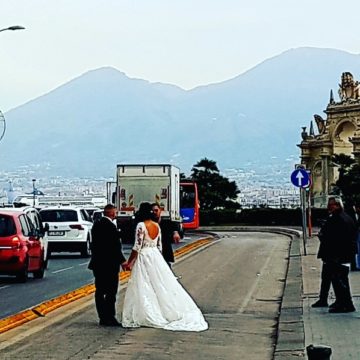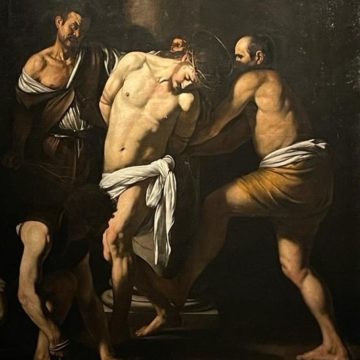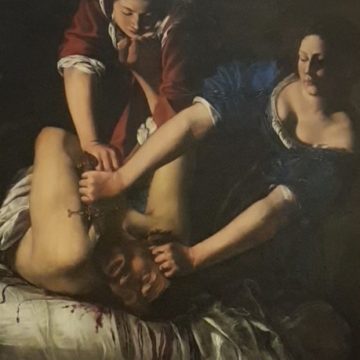by Rafaël Newman
Neapolitan conversation is impenetrable to outsiders. Ears, nose, eyes, breast and armpits are signal stations to be pressed into use by fingers, a distribution that recurs in the particular specializations of the local erotics. The foreigner is struck by so much solicitous gesturing and impatient touching, whose regularity rules out coincidence. And while the Neapolitan may betray him, even sell him out—yet in the end he bids the foreigner a good-humored addio: sends him on his way, a few kilometers down the road to the village of Mori. Vedere Napoli e poi Mori, says the Neapolitan, reciting an old joke. “See Naples and die,” echoes the German. —Walter Benjamin and Asja Lācis1

“The German,” among other foreigners, may perhaps be forgiven for reflexively associating Naples with death. There is the archaic quality of the city’s public superstition, present in the phallic horns everywhere for sale, said to be useful in warding off the fatal Evil Eye. There is the enormous hexagonal pile of the Castel Sant’Elmo looming over the city, its blank medieval walls threatening would-be invaders with doom; and there is its equally brooding partner on the harbor front, the Castel dell’Ovo, built, legend has it, upon a hidden Virgilian egg, whose fragile intactness is the only guarantee of the fortification’s survival. Just a little further afield, and ever present on the horizon, watching over all the many and varied rituals of daily life, is the sinisterly mammary double hulk of Vesuvius, mainland Europe’s only recently active volcano, an ominously smoking reminder, via the nearby ghost towns of Pompeii and Herculaneum, of a capricious and death-dealing nature. (Naples itself lies athwart the Phlegraean Fields, an area of volcanic activity under continuous seismographic surveillance.) And, shot through the entire place, invisible to the untrained eye save in the ubiquitous mounds of ostentatiously uncollected garbage, there is the loosely organized criminal society known as the Camorra, whose provision—or repression—of communal services, and whose targeted acts of violence to enforce its rule, have been mortally endangering the health of Neapolitans for centuries.
Walter Benjamin and Asja Lācis, in their 1925 essay on Neapolitan architecture, were unexpectedly downbeat about the city’s physical aspect, which, they maintained, does not provide the Mediterranean charm and balm for the eyes expected by the routine northern visitor: “Fantastical travelogues have colorized the city; in reality it is gray, a grayish red or ochre, a grayish white. And quite completely gray where it meets the sky and sea. This is not the least of the reasons for its citizens’ anhedonia. For if one has no eye for shapes, there is little to see here. The city is craggy. Seen from the heights, where the voices are unheard, from Castell San Martino, it lies extinct in the twilight, petrified.”2 And indeed, for all their vividness, the visual arts, as generously on display in Naples as in many other Italian cities, offer no more respite from this general air of memento mori (by which I do not mean a souvenir stand in the notorious neighboring village) than does its architecture.
The Museo di Capodimonte, housed in a Bourbon palazzo on extensive grounds to the northwest of the old town, contains endless suites of Italian art from the 13th to the 18th centuries, and thus offers a veritable pageant of suffering and death: massacres of innocents, martyrdoms and murders, an unrelenting parade of devotional mortality in which even the most joyous celebration of the Savior’s birth is surmounted by an image of the Virgin bearing a crucifix, token of her son’s bloody destiny.
 Among the gory splendors of the Capodimonte are works of striking violence by two of the most renowned figures in Baroque painting, each with a personal connection to Naples, and related in artistic lineage to one another. “The Flagellation of Christ” (1607/8), by Caravaggio (1571-1610), commissioned for a Neapolitan church and on display at the museum since the 1970s, is a scene of impending torture that has the force of a coiled spring. The extremities of Christ’s captors are splayed around his captive body in a pinwheel of intense labor, while the broad expanse of his exposed chest and his sorrowful head pulled to one side by a tormentor form the still center of a mechanism soon to burst into excruciating movement. It is a scene of enforced acquiescence, of unearthly beauty bowing to mundane brutality; of a luminescence that transcends the surrounding darkness while insisting on its necessity, if only for an enhanced appreciation of the light. Here, in a reversal of the prefiguring of pain and passion in various early Renaissance nativity paintings, Christ’s glowing chest seems to promise the transvaluation of individual suffering into universal salvation that will eventually come with his apotheosis. The bare chest at the painting’s center speaks to viewers with the mute power of Rilke’s archaic bust of Apollo, whose “torso / is still suffused with brilliance from inside,” and which exhorts readers to “change your life.”
Among the gory splendors of the Capodimonte are works of striking violence by two of the most renowned figures in Baroque painting, each with a personal connection to Naples, and related in artistic lineage to one another. “The Flagellation of Christ” (1607/8), by Caravaggio (1571-1610), commissioned for a Neapolitan church and on display at the museum since the 1970s, is a scene of impending torture that has the force of a coiled spring. The extremities of Christ’s captors are splayed around his captive body in a pinwheel of intense labor, while the broad expanse of his exposed chest and his sorrowful head pulled to one side by a tormentor form the still center of a mechanism soon to burst into excruciating movement. It is a scene of enforced acquiescence, of unearthly beauty bowing to mundane brutality; of a luminescence that transcends the surrounding darkness while insisting on its necessity, if only for an enhanced appreciation of the light. Here, in a reversal of the prefiguring of pain and passion in various early Renaissance nativity paintings, Christ’s glowing chest seems to promise the transvaluation of individual suffering into universal salvation that will eventually come with his apotheosis. The bare chest at the painting’s center speaks to viewers with the mute power of Rilke’s archaic bust of Apollo, whose “torso / is still suffused with brilliance from inside,” and which exhorts readers to “change your life.”
 How different is the painting hung a few rooms further on, by one of Caravaggio’s younger contemporaries, herself a signal 17th-century innovator, Artemisia Gentileschi (1593-1656). “Judith Beheading Holofernes” (1612/13) is an early version of the scene, and motif, that would come to be emblematic of Gentileschi’s career, as a female artist in a male-dominated profession and society, exposed to the prejudice, oppression, and sexualized violence of her peers, and her world. In Gentileschi’s dramatically compressed version of a subject popular among contemporary and earlier painters, Judith, the eponymous Jewish heroine, saves her people from their foe by cutting off the menacing Assyrian general’s head, having seduced and drugged him. What is remarkable about Gentileschi’s rendering is the intensity of its staging, with the limbs of the actors—Holofernes and his two assailants, Judith and her maidservant—forming a crown around the dying general’s head, a half-circle of radiant, violent energy echoed by the vividly depicted, answering half-corona of blood spraying from the slain man’s neck. The expressions on the faces of the two women are concentrated and utterly resolute, their purpose-driven gaze drawing viewers’ eyes to the painting’s center, where sword meets neck. It is commonly held that the face of Judith here is modeled on the artist’s own, making of the biblical vignette a platform for Gentileschi’s imagined vengeance on Agostino Tassi, the man who had raped her, and had subsequently escaped punishment.
How different is the painting hung a few rooms further on, by one of Caravaggio’s younger contemporaries, herself a signal 17th-century innovator, Artemisia Gentileschi (1593-1656). “Judith Beheading Holofernes” (1612/13) is an early version of the scene, and motif, that would come to be emblematic of Gentileschi’s career, as a female artist in a male-dominated profession and society, exposed to the prejudice, oppression, and sexualized violence of her peers, and her world. In Gentileschi’s dramatically compressed version of a subject popular among contemporary and earlier painters, Judith, the eponymous Jewish heroine, saves her people from their foe by cutting off the menacing Assyrian general’s head, having seduced and drugged him. What is remarkable about Gentileschi’s rendering is the intensity of its staging, with the limbs of the actors—Holofernes and his two assailants, Judith and her maidservant—forming a crown around the dying general’s head, a half-circle of radiant, violent energy echoed by the vividly depicted, answering half-corona of blood spraying from the slain man’s neck. The expressions on the faces of the two women are concentrated and utterly resolute, their purpose-driven gaze drawing viewers’ eyes to the painting’s center, where sword meets neck. It is commonly held that the face of Judith here is modeled on the artist’s own, making of the biblical vignette a platform for Gentileschi’s imagined vengeance on Agostino Tassi, the man who had raped her, and had subsequently escaped punishment.
Caravaggio’s and Gentileschi’s paintings at the Capodimonte are thus similarly choreographed scenes of violence with radically different imports: While “The Flagellation” promises eventual transcendence through passive suffering by illuminating the beautiful body of the victim, who is championed by this showcasing and whose very torso is alive with appeal, “Judith Beheading Holofernes” is an urgent call to action, whether preemptive or retributive, in the face of an oppressor, whose grotesquely staring, lifeless head is foregrounded as proof of his viciousness, while his victim—would-be or, if the autobiographical reading of the painting is accurate, actual—wields the weapon of his undoing, and of the restoration of order by violent means.
*
One foreigner—in fact, one German—who resisted the clichéd association of Naples with death was Johann Wolfgang von Goethe, the preeminent man of German letters of the late 18th and early 19th centuries, and beyond. Goethe visited Naples in 1787 on one of the forays that were to be written up in his monumental Italian Journey. He is celebrated by the city to this day, in part for his championing of its notorious lazzaroni, or impoverished masses, whose alleged indolence he reinterpreted as perpetual readiness for commerce: as vibrant industrial potential, rather than as the moribund laziness ascribed to the mezzogiorno by snooty northerners. Furthermore, having been initially dismayed by the small stature of the ruins at Pompeii, which did not conform to his classicist’s vision of the grandeur of Rome, Goethe was soon delighted to find, in the extant ancient domestic ornaments as compared with those still in use in 18th-century Campania, evidence of a continuity of regional custom that made the petrified city come alive. And he was charmed by the profusion of southern flora, as yet unfamiliar to visitors from northern Europe, or indeed the upper Italian principalities, which made of the entire region a veritably living school of botany, to the delight of the German polymath.
But Goethe went yet further in his wilful celebration of Naples as a site of vitality rather than of mortality. He scaled Vesuvius a full three times (well beyond what was expected of participants in the traditional Grand Tour) in his efforts to prove (or rather deny) its role in topographic development. For Goethe, in addition to his poetical calling an amateur scientist, was an adherent of the Neptunist school, which proposed a theory of geological evolution radically opposed to the hypotheses of its rivals, the Plutonists:
“Neptunists” and “Plutonists”: the two scientific camps were ranged against each other in Goethe’s era; and a profession of faith in either tendency had a philosophical, even religious tenor that transcended professional debate. At issue was whether formative processes (not only in the geological sense) were to be seen as gentle, harmonious, and evolutionary, or violent, volatile, and revolutionary. The Neptunists (who represented what was in the 1780s still the dominant academic opinion) assumed that the Earth’s surface had originally been covered by a primeval sea, which then gradually receded to reveal the various land masses. They interpreted even volcanic basalt as marine sedimentary rock. The Plutonists, meanwhile, assigned chief responsibility for the development of the Earth’s surface to eruptive terrestrial phenomena… Goethe was a Neptunist; the violent and the volatile were generally alien to his idea of development.3
In other words, the Plutonists’ view of the role of earthquakes and volcanic eruption in planetary development was as offensive to Goethe’s aesthetic taste—the final word in the above passage, translated as “development”, is in fact the polysemous German term for socio-cultural formation, Bildung—as it was anathema to his amateur scientific opinion; and he was remarkably obdurate in his denial of the evidence of his senses in view of actual streams of lava on those three excursions to the summit of Vesuvius. His positive opinion of the Neapolitan masses may have grown out of the same attachment to classical order and rejection of romantic disruption, and was in the event to be vindicated by the lazzaroni’s subsequent involvement in counter-revolutionary resistance to the short-lived Parthenopaean Republic established by the French in 1799, and their role in the defeat of the 1848 Revolution in Naples, which won them from Friedrich Engels the contemptuous appellation Lumpenproletariat. The common folk of Naples, it turned out, were as attached to the established aristocratic order, and as opposed to its violent overthrow, as was their distinguished German visitor.
When Goethe visited Naples in March of 1787 the Ancien Régime seemed stable and, in Naples as elsewhere in Europe, intent on its corporate survival. In fact, in response to an outbreak of smallpox, Ferdinand, King of Naples and Sicily, had just recently adopted a new and controversial approach to disease control by having his several remaining children inoculated (three had already died of the affliction; four more would eventually succumb). The local nobility were comfortably ensconced in their position, and Goethe was able to enjoy their hospitality once he had secured the necessary introductions. It did indeed seem as if the world were operating according to the writer’s preferred principle: that of gentle, gradual, law-abiding evolution, with the elite reliably fulfilling their God-given role and the people enjoined to suffer their subjection with the patience of Caravaggio’s Christ.
Just over two years following Goethe’s visit to Naples, however, the French Revolution was to challenge these eternal truths and begin the process of change that would eventually overturn, or at least radically reform, the established order in much of Europe. The violence that erupted in 1789, and more symbolically in 1793, with the beheading of Louis XVI, was to carry on in varying forms, ebbing and flowing with the times and the politics of reaction, repression, restoration, and eventual republicanism, over the next century and a half, in a cycle of bloody events reminiscent of the corona of blood streaming from the neck of Gentileschi’s Holofernes, and echoed in his limbs, and those of his avengers, pinwheeling around his dying head. Here was a vindication of the Plutonists, as their theory of the importance of violent, eruptive forces for the development of the Earth was echoed in the revolutionary rebirth of the planet’s dominant species.
And, in Gentileschi’s casting of herself as the vengeful Judith, there is a similarly revolutionary approach to the possibilities of art that is diametrically opposed to Goethe’s own, sedately classicist aesthetics, itself modeled on the German poet’s Neptunist beliefs. Gentileschi’s is an art with an activist agenda, one that pursues political ends, even if, as Maggie Nelson, in her work on freedom, echoes Sarah Lucas, “making art is like being in prison and trying to get out with a nail file”. What Gentileschi’s Judith resolutely rejects, literally in her own right, figuratively as an avatar of her creator, is the position of passive sufferer as emblematized by Caravaggio’s Christ, who succumbs to his tormentors, and to his murderers, in the name of a higher evolution to come. In her imaginary revenge on her tormentor, Gentileschi enacted the revolutionary blow that might immediately overturn the relations of personal oppression under which she labored, and thus prefigured the beheading to come, almost two centuries later, in the name of broader revolutionary ends. In “Judith Beheading Holofernes,” Gentileschi is acting “as if”, with violent, eruptive, volcanic force, in implicit contravention of Goethe’s aesthetic principle, enunciated in his programmatic poem “Nature and Art”, whereby “only law our freedom can assure.” In the words of the anarchist anthropologist David Graeber, also cited by Maggie Nelson:
Revolutionary action is not a form of self-sacrifice, a grim dedication to doing whatever it takes to achieve a future world of freedom. It is the defiant insistence on acting as if one is already free.
Acting as if one is free, of course, is not the same as being free; and in any case, in the end, none of us is free of the ultimate constraint. The manner of our final subjection, however, may vary: Caravaggio’s death in 1610 was likely the result of wounds inflicted during a violent altercation, while Gentileschi may have succumbed to the outbreak of plague that swept Naples in 1656. As for me, I saw Naples, and I did not die. But Holofernes did.
______________________________________
1 Walter Benjamin & Asja Lācis, “Neapel,” in Walter Benjamin, Gesammelte Schriften, vol. IV/I (Frankfurt, 1972), pp. 308-316; my translation.
2 Idem.
3 Dieter Richter, Goethe in Neapel (Berlin: Verlag Klaus Wagenbach, 2012), pp. 64-65; my translation. I am indebted to this elegant volume in my remarks here in general, and was guided by it through Naples during a recent trip to the city.
